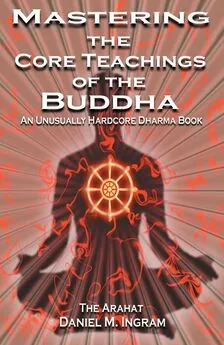Daniel Ingram - Mastering the Core Teachings of Buddha - An Unusually Hardcore Dharma Book
- Название:Mastering the Core Teachings of Buddha - An Unusually Hardcore Dharma Book
- Автор:
- Жанр:
- Издательство:Aeon Books
- Год:2009
- ISBN:9781904658405
- Рейтинг:
- Избранное:Добавить в избранное
-
Отзывы:
-
Ваша оценка:
Daniel Ingram - Mastering the Core Teachings of Buddha - An Unusually Hardcore Dharma Book краткое содержание
Mastering the Core Teachings of Buddha - An Unusually Hardcore Dharma Book - читать онлайн бесплатно полную версию (весь текст целиком)
Интервал:
Закладка:
If you have two hours each day for meditation, great! If you have two jobs, six kids, and just can’t find more than ten minutes each day for meditation, make good use of what you’ve got. There have been times in my life when I was very grateful that I had twenty hours a day to practice. On the other hand, when I have only had ten minutes a day, I have been grateful for the sense of how precious those ten minutes were. Skillful urgency and well-developed gratitude for a chance to practice at all can allow us to really use limited pieces of time to their fullest.
If you can take off a month each year for intensive retreats, wonderful. If a weekend retreat once a year is all you can do, go for it.
In short, honor where you are and what you can realistically accomplish given your current circumstances. If they are not entirely to your liking, and you want to take more time for practice, work on rearranging things a bit in a way that leaves you with a life that you still find fulfilling should you later decide to practice a bit less.
Luckily, meditation is an extremely portable endeavor. You don’t have to lug around special equipment, have other people around, or schedule an appointment. There are no fees, waiting lists, or red tape.
Reality happens. Sensations arise. If you’re payin’ careful attention to them, really feeling exactly what it is like to be here now, you’re doin’ it!
It’s just that simple.
Practical Meditation Considerations
While I have definitely come to appreciate “ideal” meditation conditions and their obvious benefits, I have also had profound insights and extraordinary experiences in places that would hardly be considered ideal (e.g. in the break room at work, while brushing my teeth). While I definitely appreciate the additional depth of long periods of uninterrupted practice, I am certain that being able to make use of little bits of time here and there has done much to move things along.
I sometimes meditate when reclining before sleep, when reclining in the morning before I have to get up, when I wake up in the middle of the night, before catnaps on the couch, during boring lectures and meetings, and in the lounge of the school I attended before afternoon classes. I have come to the conclusion that five minutes of really engaged, clear and focused practice in poor circumstances can often produce more benefits for me than an hour of poor, vague and distracted practice in “optimal conditions.”
I have also come to appreciate the value of timed sits, where I vow to sit and pay attention for a defined period of time. I take a little travel alarm clock or kitchen timer and vow to sit for a predetermined space of time, usually somewhere from 30 minutes to 1.5 hours. I have found that, during untimed sits, I tend to get up when I run into difficult territory, mild pain from sitting, or other things that I don’t want to acknowledge and investigate clearly. A timed sit makes it much more likely that I will be able to sit in the face of these things, thus developing more confidence and discipline, as well as the insights that come from persistent investigation.
DAILY LIFE AND RETREATS
A very related issue here is that of the world of retreats and monasticism and how it contrasts with the world of “daily life” or the life of a “householder.” Each has its own set of issues, but many of them overlap and the differences may be more question of degree than of dichotomy.
Now, it is true that the battle is not always to the strong, nor the race to the swift, but that’s the way to bet. In other words, those who do lots of practice in daily life, go on more and longer retreats, are more consistently able to concentrate and investigate quickly and precisely, pay attention more often during their daily activities, and have their 68
Practical Meditation Considerations
morality trip more together are, on average, much more likely to make progress.
When on retreat, people have the opportunity to practice nearly all day in settings that are usually designed to be very conducive to clear, precise inquiry and depths of meditation. (Why so few people actually take advantage of these circumstances when they go on retreat is beyond me, and I will spend some time ranting about that later.) The point is that going on retreats can give opportunities for much faster and deeper practice to those who choose to really practice. Said another way, if you go on retreat, make good use of that time.
There is a huge difference between the experiences of people who do retreats halfway and people who really follow the instructions all day long. In my experience, there is no comparison between retreats I have done when I really powered the investigation from the time I awoke until I went to sleep at night, causing fast and profound progress, and when I took breaks here and there to think about things such as my issues and meditation theory, generally causing moderate to slow progress. While many people think that retreats are for more advanced practitioners, I think that a few retreats early in one’s practice can really jump start things, allowing one to then make much better use of meditation time off retreat.
I often think of the momentum that retreats generate in terms of rolling a boulder over a hill. If you get a long running start, pushing hard the whole way, you are more likely to be able to get the boulder rolling fast enough so that it rolls over the hill in one straight shot. If you push intermittently or half-heartedly, the boulder is likely to roll back when you get to the steep part of the hill, but you have worn the hill down a little bit, and you may also be a bit stronger for the exercise. Thus, it is possible to wear down the hill given enough time, but it is much faster to simply power over it the first time and move on to the next hill. I know of no obvious benefits from slow practice that fails to gain some footholds in the territory of concentration or insight.
Those who take the wear down the hill approach may eventually lose faith and interest, having done lots of work to little effect. Those who really apply themselves and cross a few hills early on through focused and consistent effort, such as retreats or really solid daily life 69
Practical Meditation Considerations
practice, will have more of a sense of accomplishment and
empowerment, and may have even put in less total time and effort than those who tried to wear down the hill. This irony should not be lost on those who want to be smart about developing their meditative skills.
For example, lets say that you could allocate 365 hours out of one year to formal meditation practice. Given a choice, I would be more inclined to take half of those hours, about 182, and do a 10 day retreat practicing hard and consistently 18 hours a day with minimal breaks at the beginning of the year, and then spend half an hour meditating each of the other days. I would be much more likely to cross into some interesting territory early on and overcome some of the initial hurdles than if I spent one hour each day for that year practicing well. The amount of time and effort is the same, but the effect is likely to be quite different.
A few odds and ends about retreats. First, retreats tend to have a semi-predictable rhythm to them. Realizing this allows us, if we have the time and resources to space, to choose how long a retreat we want to meet our meditative goals. Even if we are practicing well, the first few days of a retreat tend to be mostly about adjusting to the place, the posture, the routine, the people, the local customs, the schedule, etc.
Similarly, the last day or two of a retreat tends to bring up thoughts of what we are going to do next. Thus, to give yourself some time in the middle when you are not dealing with these things as much, I recommend greater than 5-day retreats when possible. It is not that benefit can’t be derived from shorter retreats, but there is something about those middle days that tends to make strong concentration and good practice easier to attain.
Second, every retreat center and tradition has its neurotic shadow aspects and downsides. This is inevitable, but by identifying them and realizing that there are ways to have them not slow our investigation down is helpful. One center where I have spent a bit of time is prone to attracting very serious, scowling people who trudge around in their walking practice like the slightest sound or glance from anyone around them might set them off like a bomb. I have been to another center where sometimes I have been the only meditator there, requiring me to have more self motivation and discipline. Another monastic center I 70
Practical Meditation Considerations
have been to has the whole male hierarchy thing going which can cause all sorts of reactions from retreatants both female and male.
Then there are basically always neurotic things around food (huge topic, of which vegetarian vs. non-vegetarian is just the tip of the iceberg), bathrooms, quarters, showers, hot water, washing clothes and dishes, cleaning duties, heating and cooling (one place I have been to has cantankerous wood stoves in some buildings for heat, another in a tropical setting has open windows that let the mosquitoes swarm in), clothing (e.g. some centers have people wear white, others won’t tolerate skimpy or revealing outfits, some don’t care), fragrances, chemical sensitivities, incense, morning wake-up bells (too quiet, too loud, someone forgets to ring it at all), schedules, roommates (particularly those that snore, smell, are noisy or messy, etc.), strictness of silence, eye contact or the lack thereof, etiquette around teachers (e.g. to bow or not, to ask challenging questions or not, limits on the time we have access to them, their personalities and neurotic stuff, whether or not they speak the language we speak, etc.), etiquette of entering rooms with icons (e.g. whether to bow three times or not), the presence of icons or not (and which icons), and issues of the orthodoxy of ritual, dogma, posture, hand position, eating rituals, chanting, vows, etc.
This list doesn’t include issues of corruption, romances, cults of personality, affairs, crushes, miscommunications, vendettas, scandals, drug use, money issues, and all the other things that can sometimes show up anywhere there are people. In short, whatever you imagine that you or other people might have issues around, these are bound to show up sooner or later if you spend enough time in spiritual circles or retreat centers. While solo practice is an option, that doesn’t get you away from all of these issues and has its own set of downsides.
The crucial thing is to realize that great practice can occur in conditions far from perfect, particularly if we realize that all the sensations that make up these inputs and our reactions to them are all worthy of investigation and thus as much a source of ultimate and often relative wisdom as any other sensations. I have rarely had what I considered perfect practice conditions, but I have done well and you can also. That said, some centers, particular retreats, and teachers are better than others, and it is worth exploring and asking around. All these 71
Practical Meditation Considerations
things can be particularly distracting and distressing for a first time retreatant, as often there are some naïve hopes, however
unacknowledged, of walking into the Garden of Eden, sitting with the Buddha, and hanging out with the most evolved fellow retreatants one could imagine.
When off retreat, progress is still possible, particularly if one has used retreats to get past some of the initial hurdles (hills) and get a few tastes of what is possible. Do not underestimate the value of careful and honest awareness of what one is going during one’s life off the cushion.
Читать дальшеИнтервал:
Закладка:





![Дженнифер Гюнтер - The vagina book. Главная книга для тех, у кого есть этот орган [litres]](/books/1061538/dzhennifer-gyunter-the-vagina-book-glavnaya-kniga-dl.webp)




